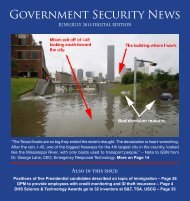Government Security News
Create successful ePaper yourself
Turn your PDF publications into a flip-book with our unique Google optimized e-Paper software.
International training essential to<br />
global stability and security<br />
Continued from page 26<br />
close striking distance. And if<br />
viable threats do exist, nations<br />
with autonomous capability can<br />
contain them without U.S. assistance<br />
in most cases. Finally,<br />
in the extreme cases where a local<br />
or regional threat is not easily<br />
contained with indigenous forces,<br />
threatened partner nations<br />
can function inter-operably with<br />
U.S. and/or other friendly foreign<br />
forces to most effectively neutralize<br />
menaces to stability.<br />
We are currently seeing a<br />
shift to more U.S. defense contractors<br />
performing and/or providing<br />
support to security assistance<br />
missions utilizing an<br />
extremely capable cohort of<br />
largely former military personnel.<br />
This U.S. veteran workforce<br />
combined with highly motivated<br />
private sector individuals is ensuring<br />
critical missions continue<br />
to successfully train and better<br />
prepare foreign military partners<br />
for self-defense and/or coalition<br />
participation.<br />
The U.S. will always play an<br />
important role in international<br />
stability and the future will rely<br />
more and more on the strength<br />
and capability of our partners.<br />
Increasing the capability of our<br />
partners through security assistance<br />
training is the most effective<br />
solution to mitigate the U.S. military<br />
drawdown<br />
while preserving<br />
regional and<br />
global security.<br />
We simply can’t<br />
afford not to!<br />
Scott Seavers, former USAF Colonel<br />
and Air Force <strong>Security</strong> Assistance<br />
Training Commander, is a<br />
Vice President at Salient Federal<br />
Solutions in Fairfax, Virginia.<br />
U.S./Canada sign preclearance<br />
agreement<br />
Continued from page 5<br />
by which CBP Officers stationed<br />
abroad screen and make admissibility<br />
decisions about passengers<br />
and their accompanying goods<br />
or baggage heading to the United<br />
States before they leave a foreign<br />
port. CBP officers do, however,<br />
42<br />
retain the authority to inspect<br />
passengers and their accompanying<br />
goods or baggage after<br />
arriving in the United States.<br />
CBP officers currently conduct<br />
preclearance operations at eight<br />
Canadian airports: Calgary, Edmonton,<br />
Halifax, Montreal, Ottawa,<br />
Toronto, Vancouver and<br />
Winnipeg.<br />
This agreement achieves a<br />
key component of the Beyond<br />
the Border: A Shared Vision for<br />
Perimeter <strong>Security</strong> and Economic<br />
Competitiveness Action<br />
Plan. On February 4, 2011, President<br />
Obama and Prime Minister<br />
Harper released the Beyond the<br />
Border Declaration, articulating a<br />
shared vision in which our countries<br />
work together to address<br />
threats at the earliest point possible<br />
while facilitating the legitimate<br />
movement of people, goods<br />
and services across our shared<br />
border. The Action Plan outlines<br />
the specific steps our countries<br />
intend to take to achieve the security<br />
and economic competitiveness<br />
goals outlined in the Beyond<br />
the Border Declaration.<br />
For more information, visit<br />
www.dhs.gov.







